Charles E W Bean, Diaries, AWM38 3DRL 606/264/1 - 1914 - 1938 - Part 1
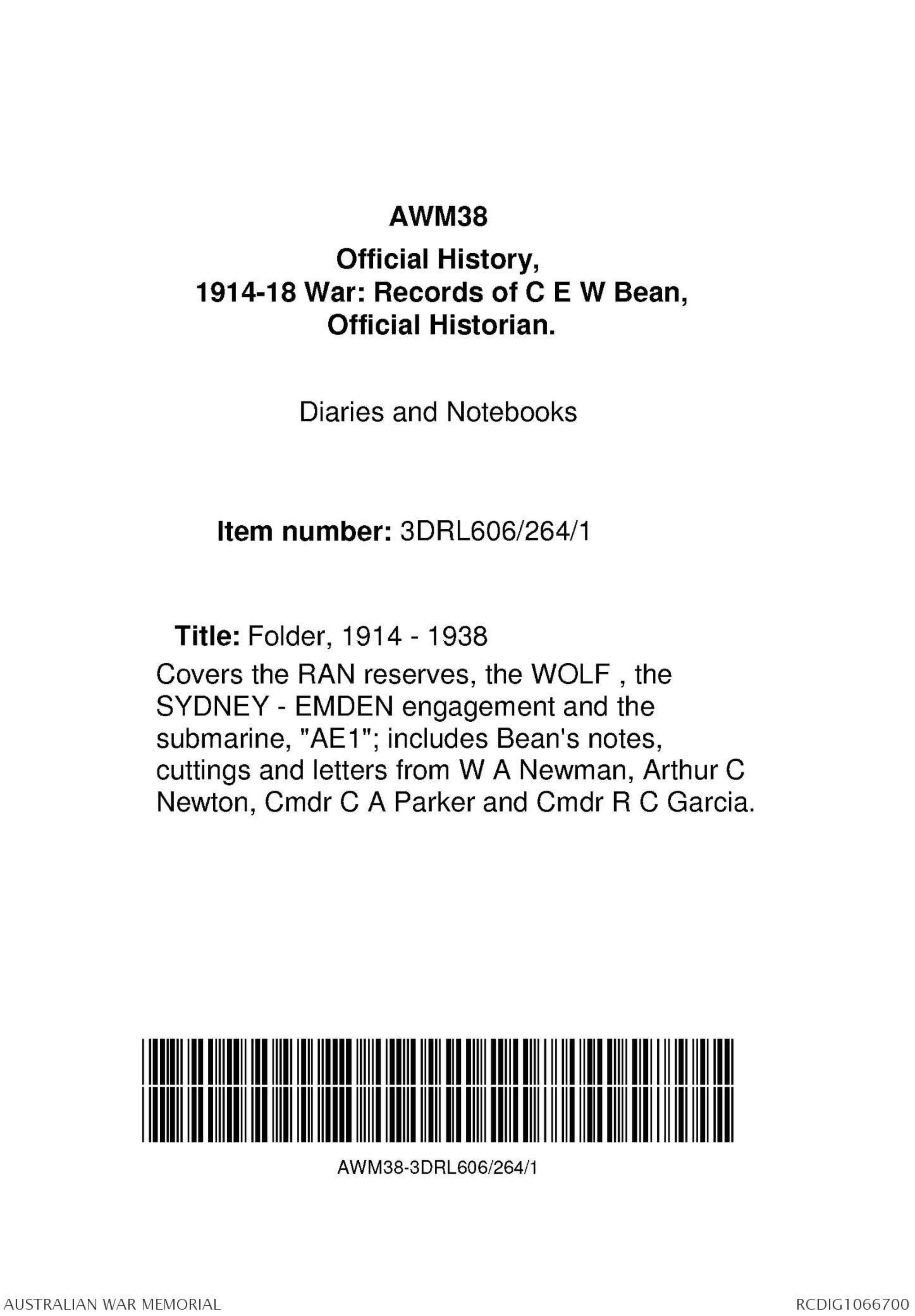
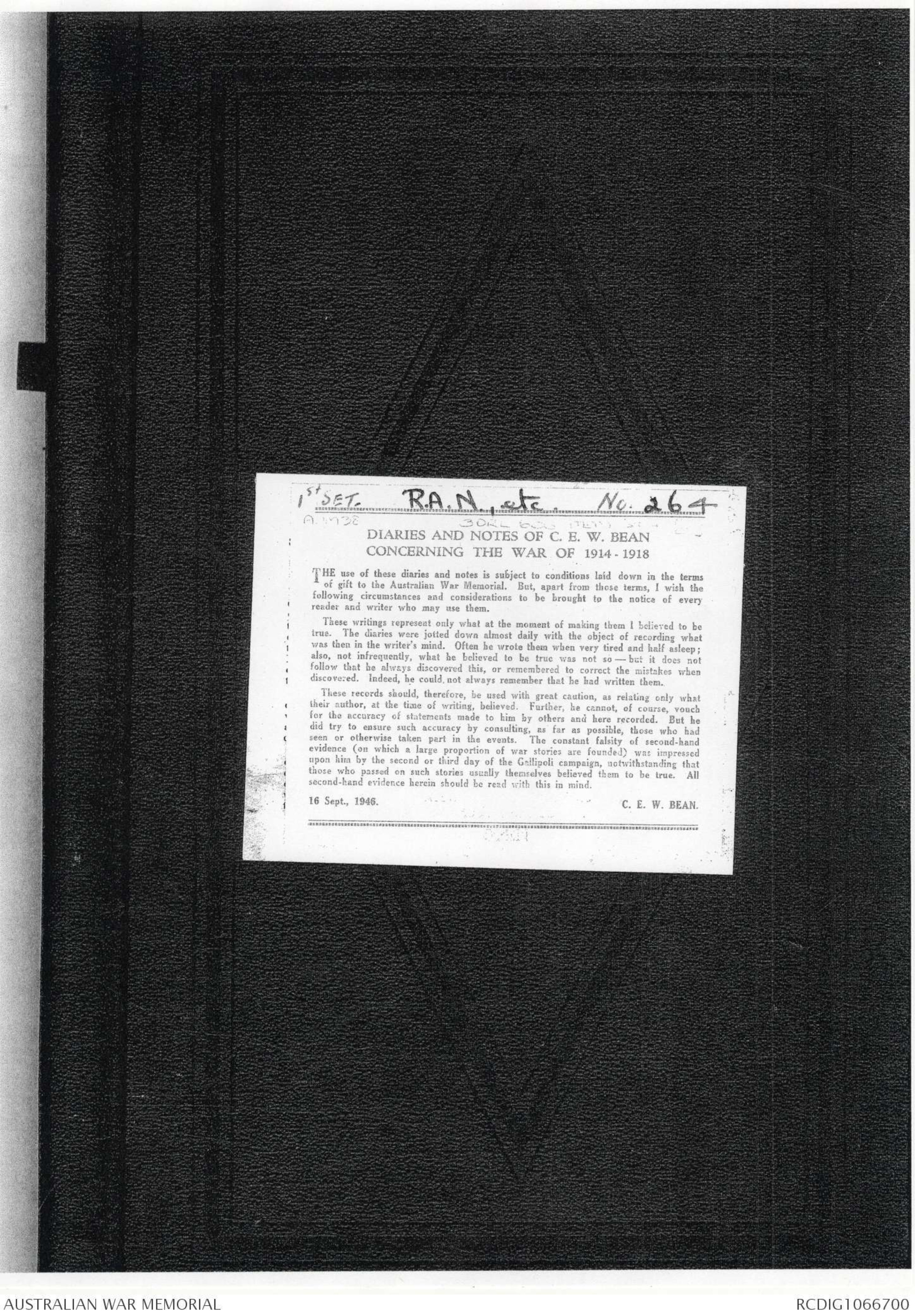





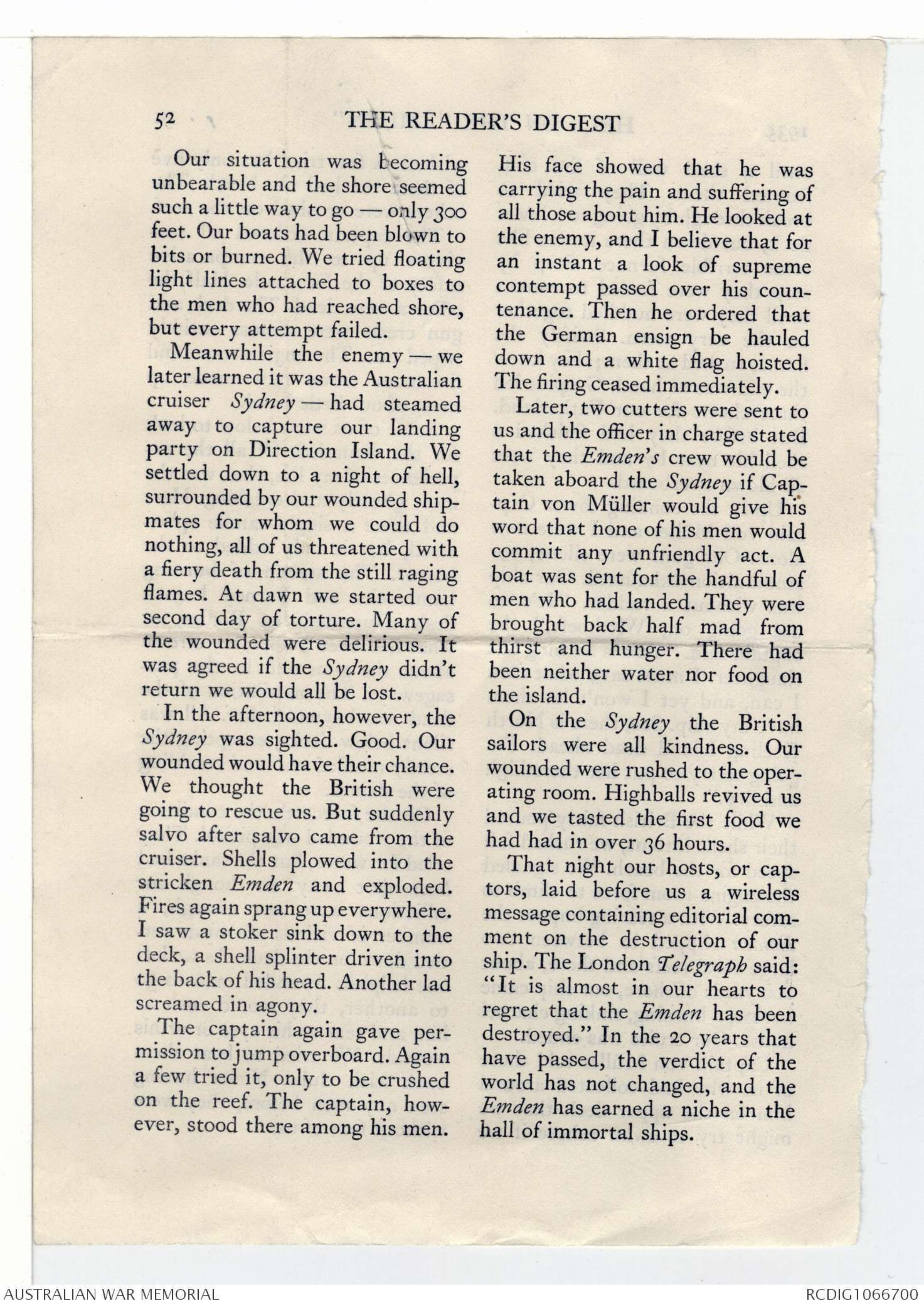

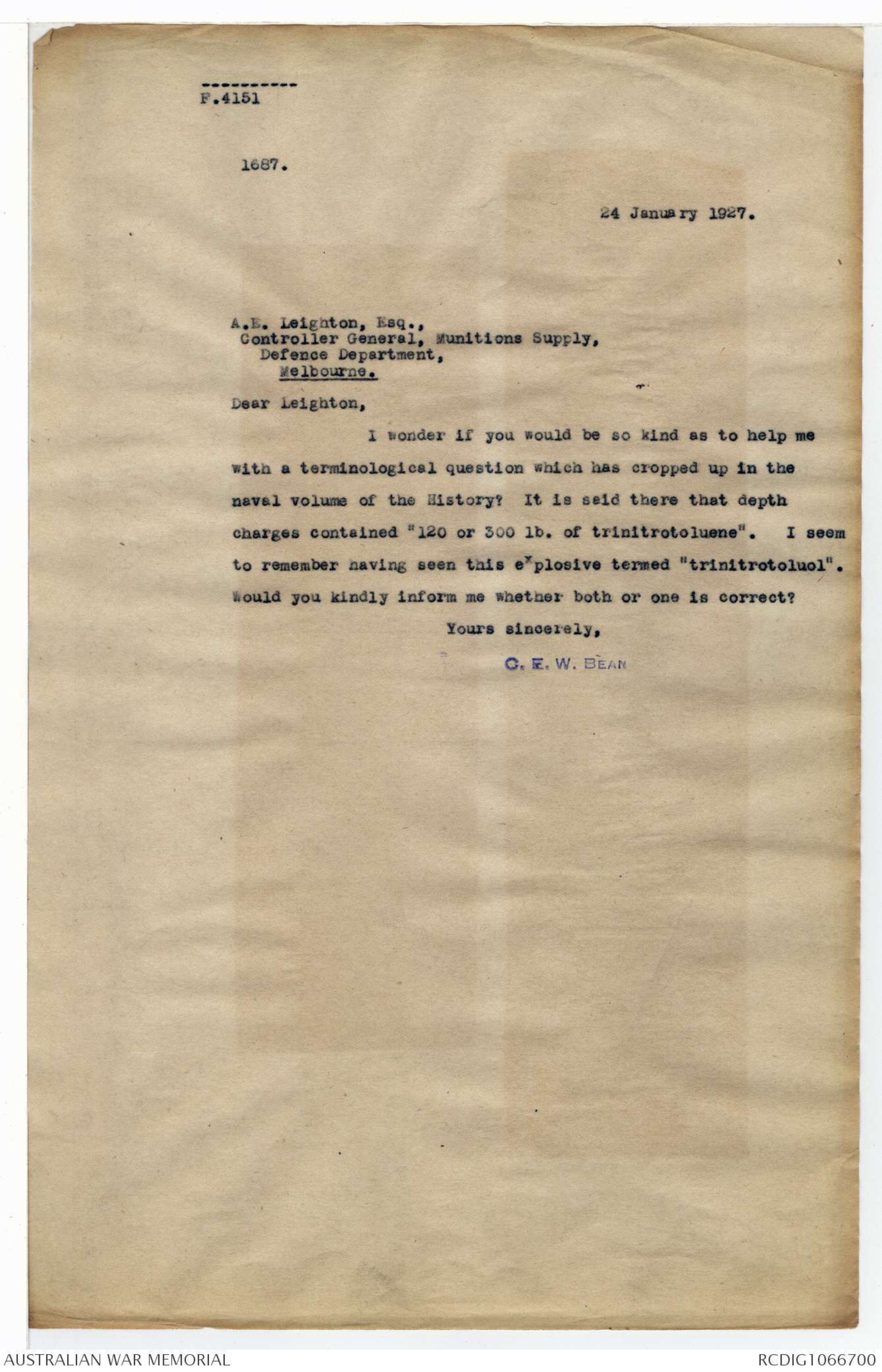
AWM38
Official History,
1914-18 War: Records of C E W Bean,
Official Historian.
Diaries and Notebooks
ltem number: 3DRL606/264/1
Title: Folder, 1914 - 1938
Covers the RAN reserves, the WOLF, the
SYDNEY - EMDEN engagement and the
submarine, "AE1"; includes Bean’s notes,
cuttings and letters from W A Newman, Arthur C
Newton, Cmdr C A Parker and Cmdr R C Garcia.
AWM38-3DRL606/264/1
1st SET. R.A.N., etc. No. 264
AWM38 3DRL 606 ITEM [[?]]
DIARIES AND NOTES OF C. E. W. BEAN
CONCERNING THE WAR OF 1914 - 1918
THE use of these diaries and notes is subject to conditions laid down in the terms
of gift to the Australian War Memorial. But, apart from those terms, I wish the
following circumstances and considerations to be brought to the notice of every
reader and writer who may use them.
These writings represent only what at the moment of making them I believed to be
true. The diaries were jotted down almost daily with the object of recording what
was then in the writer's mind. Often he wrote them when very tired and half asleep;
also, not infrequently, what he believed to be true was not so — but it does not
follow that he always discovered this, or remembered to correct the mistakes when
discovered. Indeed, he could not always remember that he had written them.
These records should, therefore, be used with great caution, as relating only what
their author, at the time of writing, believed. Further, he cannot, of course, vouch
for the accuracy of statements made to him by others and here recorded. But he
did try to ensure such accuracy by consulting, as far as possible, those who had
seen or otherwise taken part in the events. The constant falsity of second-hand
evidence (on which a large proportion of war stories are founded) was impressed
upon him by the second or third day of the Gallipoli campaign, notwithstanding that
those who passed on such stories usually themselves believed them to be true. All
second-hand evidence herein should be read with this in mind.
16 Sept., 1946. C. E. W. BEAN.
[*Sydney Morning Herald
29/12/37*]
WRECK OF EMDEN
RIFLED.
Japanese Ship Seized.
30 TONS OF METAL ABOARD.
SINGAPORE, Dec. 28.
The marine police to-day seized the
Japanese-owned fishing vessel Anyo
Maru when it arrived here. A search
revealed 30 tons of bronze and other
metal salvaged from the wreck of the
German cruiser Emden at the Cocos
Islands.
It was the same vessel which brought some
unexploded shells to Singapore in October.
The Emden was damaged and was run
ashore at the Cocos Islands in 1914 during an
engagement with the Australian cruiser
Sydney.
[*S.M. Herald
14/10/37*]
TINGIRA SOLD.
To Be Resold to
Former Owners.
FAMOUS TRAINING SHIP.
The former training ship Tingira,
once, as the Sobraon, the pride of the
Australian merchant marine, was sold
at auction yesterday to satisfy a debt
incurred under a bill of sale, but it was
learned last night that the purchaser
had agreed to sell the ship back to the
former owners.
The vessel was sold by order of the
mortgagee, Mr. Adam Aberline, and was
bought for £1050 by Mr. K. Silvinen, demolition
contractor, of Balmain. It was to have
been sold last week, but the sale was prevented
then by an injunction granted to the
owners, Mr. Sydney Friere and Mrs. Louisa
Ankin.
Mr. Friere, on behalf of himself and Mrs.
Louisa Ankin, stated last night that Mr.
Silvinen had agreed to sell the Tingira back
to them at a small profit.
Mr. Friere said that they could have raised
sufficient money to wipe off the mortgage if
they had had a little more time. They had
invested about £6000 in the ship, and their
main object had been to save the vessel from
demolition.
It was a bleak scene when the little party
gathered on the after-deck of the Tingira
yesterday as she lay in Berry's Bay, and the
auctioneer (Mr. K. W. Huenerbein, of F. R.
Strange, Ltd.) mounted a companionway to
call for bids.
At least three of those present—Captains
Selwyn Day and T. W. Arthur, and Mr. S. S.
Dodgson, who had served in the old Sobraon
—must have felt the contrast bitterly. The
Tingira they boarded yesterday was a rusty
hulk, her gold scroll-work tarnished, her
white paint flaked, and weeds thick on her
keel. Portholes with broken windows gaped
forlornly, and the wind rattled frayed shrouds
and ratlines.
The auctioneer used a historic gavel presented
to him for the purpose by Captain
Arthur. Its head was of teak from the Foudroyant,
Nelson's flagship at the Battle of the
Nile, and its handle of teak from the famous
Victory. Bidding began at £200, and advanced
by £50 rises to £1050, when the
vessel was "knocked down."
Last week the Chief Judge in Equity adjourned
until yesterday an application to
restrain Mr. Aberline from offering the ship
for sale. On the matter being called yesterday
the only order asked for was dismissal of
the summons with leave to the mortgagee to
add costs to the mortgage debt.
[*HN*]
Such is war at sea—
Hell on the “Emden"
Condensed from Liberty
Rear Admiral Robert Witthoeft
of the German Navy
As told to Wayne Francis Palmer
The German cruiser Emden was
the terror of the Pacific and Indian
Oceans during the early months of
the World War. Operating alone and
without a base, and with half the
world against her, she harried Allied
shipping in one of the most daring sea
raids of all time. Starting from China,
where she was stationed when war
was declared in August, 1914, the
Emden blocked the transportation of
Anzac troops to France, shelled
British oil reserves at Madras, and
sank some $15,000,000 worth of
shipping, after first removing non-combatant
crews. In one typical raid
she crept at dawn into the harbor of
Penang and blew up a Russian
cruiser with a sudden hail of shells
that gave the doomed crew not
even a chance to fight. But on November
9, 1914, she was surprised in
turn. While putting a landing party
ashore to destroy a British cable
station on Direction Island, Captain
von Müller of the Emden sighted a
hostile cruiser approaching. One of
the Emden's officers here describes
what followed.
THE BUGLE BLARED. There was
the tramping of feet as men
rushed to their battle stations.
Gun breeches banged. Then order
and silence reigned as the Emden
steamed out to meet the enemy.
It looks like the Newcastle,"
said the captain as he squinted
through the slit in the conning
tower. “That’s not so bad. She
may have a little more gun power
than we - but l’ve got the Emden’s
crew! Full speed ahead."
We were the first to open fire,
at about 10,000 yards, on a
course parallel with the mysterious
British cruiser. Our third
salvo struck her upper works and
sent up a cloud of black smoke.
“First blood!” Gunnery Officer
Gaede yelled. “We’ve got their
range. Now let them have it."
Meanwhile, there was a flash
of orange flame from the other
ship as they gave us their broadside.
We could actually pick up
the shells as they came toward us,
looking like so many bluebottle
flies. They seemed to waver as
they neared, and then we lost
them as they moaned over us.
Soon, however, great geysers began
rising out of the sea so close
© 1935, Liberty Pub. Corp., 1926 Broadway, N. Y. C.
(Liberty, August 24, ’35)
49
[*U.S.A.*]
50 THE READER’S DIGEST October
to us that they brought tons of
water crashing down on our deck.
"We’re in for trouble," Captain
von Müller said quietly.
“Those splashes are from a much
heavier ship than I had thought."
He turned to the navigating officer.
"Closer, Gropius, closer," he
ordered.
And the Emden edged over
toward the enemy to reduce the
range. Under the clouds of yellowish
smoke that billowed above
her I saw our shells striking home
time after time; but meanwhile
her shots were getting uncomfortably
near us. Then with a crash
the first shell came aboard us and
burst in the wireless cabin. Instantly
nothing was left but its
twisted white-hot steel frame.
Our faithful operators, who had
for so long been our only link
with the outside world, were
destroyed.
Immediately thereafter a shell
burst with an appalling noise
directly in front of the conning
tower. For the next few seconds
everything was strangely silent.
We missed the rapid bark of the
forward gun, but in its place
came the groaning of the wounded
and dying. It was a frightful
mess out there. Gaede called up a
reserve crew; and the captain
repeated his order: "Closer, Gropius,
closer!"
But already we knew that we
did not have a chance. They
would run out as we tried to close
in, and then with their longer
range guns they would pound us
unmercifully. The battle became
a nightmare to me. Lieutenant
Zimmerman, seeing that there
was more trouble with the forecastle
gun, dashed forward from
the conning tower. Just as he
arrived an explosion killed him
and every man at the gun. That
same shell got the captain and
myself, but only slightly.
The forward smokestack was
hit and collapsed. The foremast
came down and slid off into the
sea, carrying with it the foremast
crew. Gropius dashed aft to see
what was wrong with the rudder.
There was now a slackening in
our rate of gunfire, and Gaede
left the conning tower to find out
why. He hadn't gone far before a
shell splinter got him, and he fell
dying to the deck, his white
uniform drenched with blood.
Our two remaining stacks were
hit and took a cockeyed tilt.
Suddenly there was a ghastly
concussion somewhere amidships
as the deck folded up and buckled.
A broadside gun hurtled up into
the air. Men, steel plates, mess
benches, and great splinters could
be seen in the flying mass of debris.
Everything seemed on fire at
once.
Gropius was caught aft with
the few survivors from the poop
gun. Intent on what they were
doing, they didn't notice that the
flames were eating their way aft
1935 HELL ON THE "EMDEN" 51
until a solid wall of fire confronted
them. They tried to
break through by going to a lower
deck, but down there it was like
some terrible furnace. Step by
step they were forced to retreat
until they were huddled together
on the very stern. Swiftly the
flames rushed at them; they knew
the end was at hand. Gropius led
three cheers for our Fatherland.
But before they had finished a
shell hit near by and they were
all blown overboard.
Up in the conning tower Captain
von Müller and I were now
alone. Our guns were silent; our
ammunition exhausted. Our ship
was without a rudder. “It’s no
use going on, Witthoeft,” the
captain said. "This is nothing but
slaughter. I must save what men
I can, and yet I won’t let them
have my ship. See, there is North
Keeling Island dead ahead. l’m
going to try to put her there high
and dry".
While the British fairly poured
their shells into us, we rushed full
speed for the beach. We signaled
the engine-room force to climb to
safety. With a tearing impact the
Emden slipped in between two
large coral reefs and there, about
100 yards offshore, our ship came
to rest, a burning, sinking charnel
house. Our cruise was ended.
Captain von Müller told those
of us who had collected around
him on the upper deck that we
might try to swim ashore if we
wished. A few tried but only five
of them reached the beach. The
others were crushed on the reef.
The captain ordered all survivors
up to the comparative
safety of the forecastle. Half the
officers were dead. The deck and
gun crews were almost entirely
wiped out. The engine-room and
fire-room crews now made up
most of our little band.
Some of us went below to look
for the wounded. Of all the
experiences of my life, that was the
most ghastly and crushing. Here
and there a single candle spluttered,
but it only added to the
horror. The stench of burning
hammocks and burned human
flesh nauseated us. Bodies, or
what had been bodies, lay strewn
about the guns and in the
passageways. The mutilation of the
dead was beyond belief. All was
silent below decks, excepting the
steady muffled roar and crackling
of the flames.
On the forecastle the condition
of the wounded was pitiful. They
cried for water, but the tanks had
been shot away. As though our
afflictions were not enough, a
number of vicious sea birds settled
down on the deck. As we left
one helpless wounded man to go
to another, they would rush at
him and tear at his eyes or at his
wounds. We tried to beat them
back with clubs. Never having
seen any men before, they were
without fear of us.
52 THE READER’S DIGEST
Our situation was becoming
unbearable and the shore seemed
such a little way to go - only 300
feet. Our boats had been blown to
bits or burned. We tried floating
light lines attached to boxes to
the men who had reached shore,
but every attempt failed.
Meanwhile the enemy - we
later learned it was the Australian
cruiser Sydney—had steamed
away to capture our landing
party on Direction Island. We
settled down to a night of hell,
surrounded by our wounded
shipmates for whom we could do
nothing, all of us threatened with
a fiery death from the still raging
flames. At dawn we started our
second day of torture. Many of
the wounded were delirious. It
was agreed if the Sydney didn’t
return we would all be lost.
In the afternoon, however, the
Sydney was sighted. Good. Our
wounded would have their chance.
We thought the British were
going to rescue us. But suddenly
salvo after salvo came from the
cruiser. Shells plowed into the
stricken Emden and exploded.
Fires again sprang up everywhere.
I saw a stoker sink down to the
deck, a shell splinter driven into
the back of his head. Another lad
screamed in agony.
The captain again gave permission
to jump overboard. Again
a few tried it, only to be crushed
on the reef. The captain, however,
stood there among his men.
His face showed that he was
carrying the paid and suffering of
all those about him. He looked at
the enemy, and I believe that for
an instant a look of supreme
contempt passed over his
countenance. Then he ordered that
the German ensign be hauled
down and a white flag hoisted.
The firing ceased immediately.
Later, two cutters were sent to
us and the officer in charge stated
that the Emden's crew would be
taken aboard the Sydney if Captain
von Müller would give his
word that none of his men would
commit any unfriendly act. A
boat was sent for the handful of
men who had landed. They were
brought back half mad from
thirst and hunger. There had
been neither water nor food on
the island.
On the Sydney the British
sailors were all kindness. Our
wounded were rushed to the
operating room. Highballs revived us
and we tasted the first food we
had had in over 36 hours.
That night our hosts, or captors,
laid before us a wireless
message containing editorial
comment on the destruction of our
ship. The London Telegraph said:
"It is almost in our hearts to
regret that the Emden has been
destroyed." In the 20 years that
have passed, the verdict of the
world has not changed, and the
Emden has earned a niche in the
hall of immortal ships.
[*Sydney Morning Herald
2/5/35*]
VON SPEE
[*2/5/35*]
"Did Not Intend to Attack"
AUSTRALIAN PORTS.
Articles published in the "Herald" last
year giving intimate details of the movements
of the German Squadron under Count von
Spee in the Pacific in 1914 prompted the
editor of "Die Bruecke," a German-Australian
weekly paper published in Sydney, to
seek from naval headquarters in Berlin a
denial of "frequent assertions" that Von
Spee had intended to attack Australian
ports. The response came in the form of an
article to "Die Bruecke" by Rear-Admiral
Walther Koehler, retired, one of the few
survivors of the German cruiser Leipzig. The
article is published in two consecutive numbers
of the "Die Bruecke," from which the
following is taken:-
The assertion that Count Spee and his
squadron had at the beginning of the war
intended to bombard Australian ports, and
that he was prevented from doing so apparently
only by the presence of the battlecruiser
Australia, has played a large part
in the propaganda carried on in the Australian
Press in favour of an increase of the Australian
naval forces. As a matter of fact,
not only had the chief of the German squadron
not harboured such an intention, but
also the instructions which he had received
from the German naval headquarters for
naval action in the case of war contained
nothing to suggest any such action.
The general plan of operations for German
warships abroad, which had been approved by
the German Emperor, and which formed the
basis for all further manoeuvres in the case
of war with Great Britain or a coalition, including
Great Britain, stated, in the first
place, that: "Ships abroad have to carry out
a cruiser warfare, except where instructions
to the contrary are given." Cruiser warfare
means war on the enemy's trade. The
explanatory notes issued by the German
Admiralty with reference to the Imperial plan
of operations just mentioned set forth that
the principal aim of all operations in the
Pacific Ocean was to damage British trade as
much as possible.
In making provision for the operative plan
of Count Spee, an attack on Australian trade
and Australian ports came up for discussion
as one of the possibilities. However, even in
these peace-time discussions such a project
was considered of only subordinate significance,
because it was stated in the plan that
"Points of attack which promise success are
the trade routes in the vicinity of Japan,
the Gulf of Petchili, the Yangtze estuary,
Hongkong, the Straits of Malacca, and non-fortified
ports in the British colonies, and in
the second place only Australia and India."
Count Spee learnt that war had commenced
when he and his flagship, the Scharnhorst,
were on a peaceful mission in the then
German port of Ponape. His other armoured
cruiser, the Gneisenau, was with him, and
reserves of coal were carried on the small
accompanying steamer Titania and the
Japanese collier Fukoku Maru. The official
German history of the naval war, published
by the German marine authorities, gives the
following details of the considerations of
Count Spee in the period of tension on the
eve of the war, and which he set forth in his
war diary:-
In the events of war "B" and "C" (against
France, Russia, and England), without any
complications with Japan, a war on trade is possible as
long as coal supplies last. However, in view of
the fact that it is apparently planned to make the
Australian naval forces participate, this is possible
for a short time only. Should Japan present any
demands, such as not to be morally bound to put
into effect her alliance with Britain, the plan of
cruiser warfare in Far Eastern waters must be
abandoned as being quite impracticable. In such
an event I intend to follow the same course as if
Japan was in face our enemy, an event calling
for our departure from the Far East according
to the plan.
And later,
In the event of war "C" (against England) and
in case Japan should demand conditions, it will
be for the cruiser squadron to proceed to the west
coast of America, because the chances of coaling
there are more certain than in other places.
On August 2, 1914 (when the position of
England had not yet become clear), Count
Spee wrote:-
The general plan in the event of war "C"
(against England) provides, in the first place, for
a raid in the direction of the Straits of Malacca;
modifications can be introduced in accordance with
subsequent developments, and again: As long as
England keeps back her interests must be respected
in the most delicate manner: however, there is
always the chance that political reasons will prompt
her suddenly to attack us from the rear.
These considerations had to be revised when
Count Spee learnt that Japan would remain
neutral only provided no German attack was
directed against any British possessions in
Eastern Asia. Count Spee noted in his diary
in the following manner: "Britain's mutual
arrangement with Japan in respect of British
Far Eastern possessions prohibits our projected
raid on the Malacca Straits, so as to
prevent Japan from taking action against
Tsingtau." He expresses the same idea in a
cable to the Governor of Tsingtau: "Am in
receipt of Japan's conditions of neutrality. I
shall not attack British territories in Eastern
Asia."
The intentions of the commander of the
German squadron are even more clearly
defined in a cable of August 5 addressed to the
German Admiralty in Berlin:-
In view of Japanese neutrality terms consider
necessary in the event of war with England to leave
the East Asiatic zone provided that coal supplies
can be arranged, and will either wage a cruiser
war in the Indian Ocean or attempt to reach home
around South America. In such case request
arrange coal supplies in Chile.
This most important cable never reached
its destination, nor did the following sent by
the Admiralty in Berlin to the squadron:-
In case Japan makes her neutrality dependent
upon no hostilities occurring in Eastern Asia, must
attempt to transfer cruiser war to another locality.
Thus the Admiralty in Berlin apparently
did not plan an attack upon Australian ports
even under the altered circumstances. Against
the objection that all these considerations
and the cables cited belonged to a period
before Japan had actually come into the war,
and that an intention of attacking Australia
might have been formed at a later period, a
telegram of the German naval attache at
Tokyo will show how he regarded the position
of the squadron and its chances of success:
he wrote:-
Recommend upon Japan's declaration of war that
cruiser squadron should escape to west coast of
South America, because enemy's fleet apparently
intends sailing to South Seas.
This suggestion seems to have had a decisive
influence upon Count Spee's resolutions,
because he put down in his diary:
Should this report be confirmed, our squadron
will not be able to hold its own against
overwhelming forces, and, in order to avoid useless
destruction, it must vanish for the time being. A
raid into the Indian Ocean would render it
impossible for the squadron to replenish its supplies
of coal after exhaustion of those on hand, even
if it were possible to get such supplies without
hindrance through the lines of the enemy blockade,
because in those parts there are neither neutral
coaling stations nor connections with reliable
middlemen. A cruise to the Western American
coast places these two requirements at our
disposal; the Japanese navy will not follow us there
without gravely disturbing the United States, and
thus influencing them in our favour.
That as early as August 13 he had made
up his mind not to proceed to Australia, but
to sail for America, is confirmed by a statement
written down by Captain von Muller,
commander of the cruiser Emden, after a
conference of all the German commandants
on board the flagship. He writes:-
The commander of the squadron expounded his
views on the situation and on the most useful
policy of the cruiser squadron. He pointed to
the menacing attitude of Japan, to the advantages
arising from keeping the cruiser squadron intact
as long as possible, and from the fact that absence
of knowledge regarding its movements and aims
would tie up large numbers of enemy ships, finally
to the difficulties connected with the consumption of
coal by the Scharnhorst and the Gneisenau.
He states that after detailed considerations
the Admiral had resolved first of all to proceed
with the squadron to the western coast
of America. Asked his personal opinion, the
commander of the Emden urged: "If the
difficulties in providing coal for the operations of
the squadron in East Asiatic, Australian and
Indian waters are too great, I would beg to
consider whether it would not be advisable
to despatch at least one of the small cruisers
of the squadron to the Indian Ocean."
If Japan's attitude was responsible for the
departure from East Asiatic waters, the problem
of coal supplies was responsible for deciding
upon the region to which the theatre
of war operations had to be transferred. The
only locality promising success to Admiral
Count Spee seemed to be South American and
not Australian waters.
F.4151
1687.
24 January 1927.
A. E. Leighton, Esq.,
Controller General, Munitions Supply,
Defence Department,
Melbourne.
Dear Leighton,
I wonder if you would be so kind as to help me
with a terminological question which has cropped up in the
naval volume of the History? It is said there that depth
charges contained "120 or 300 1b. of trinitrotoluene". I seem
to remember having seen this explosive termed "trinitrotoluol".
Would you kindly inform me whether both or one is correct?
Yours sincerely,
C. E. W. BEAN
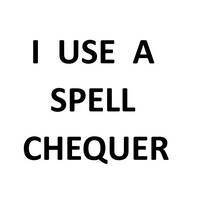 Not Yet Replaced By AI
Not Yet Replaced By AIThis transcription item is now locked to you for editing. To release the lock either Save your changes or Cancel.
This lock will be automatically released after 60 minutes of inactivity.